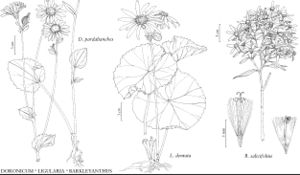Difference between revisions of "Barkleyanthus salicifolius"
Phytologia 27: 407. 1974.
Basionym: Cineraria salicifolia Kunth in A. von Humboldt et al., Nov. Gen. Sp. 4(fol.): 148. 1818; 4(qto.): 188. 1820
Synonyms: Senecio salignus de Candolle
FNA>Volume Importer |
FNA>Volume Importer |
||
| Line 7: | Line 7: | ||
|year=1974 | |year=1974 | ||
}} | }} | ||
| − | |basionyms={{Treatment/ID/ | + | |basionyms={{Treatment/ID/Basionym |
|name=Cineraria salicifolia | |name=Cineraria salicifolia | ||
|authority=Kunth | |authority=Kunth | ||
| + | |publication_title=in A. von Humboldt et al., Nov. Gen. Sp. | ||
| + | |publication_place=4(fol.): 148. 1818; 4(qto.): 188. 1820 | ||
}} | }} | ||
|synonyms={{Treatment/ID/Synonym | |synonyms={{Treatment/ID/Synonym | ||
| Line 53: | Line 55: | ||
|publication year=1974 | |publication year=1974 | ||
|special status= | |special status= | ||
| − | |source xml=https://jpend@bitbucket.org/aafc-mbb/fna-data-curation.git/src/ | + | |source xml=https://jpend@bitbucket.org/aafc-mbb/fna-data-curation.git/src/f6b125a955440c0872999024f038d74684f65921/coarse_grained_fna_xml/V19-20-21/V20_1379.xml |
|tribe=Asteraceae tribe Senecioneae | |tribe=Asteraceae tribe Senecioneae | ||
|genus=Barkleyanthus | |genus=Barkleyanthus | ||
Revision as of 19:41, 24 September 2019
Stems abundantly branched, arching distally. Leaves tapering to weakly defined petioles; blades 3–10(–15) × 0.5–1.5 cm. Heads (3–)8–16 in each array, arrays usually clustered. Phyllaries 4–6(–8) mm, tips green, obtuse. Ray corollas 8–12+ mm. Disc corollas (5–)7–8+ mm. Cypselae (1.5–)2–3 mm; pappi 5–6+ mm. 2n = 60.
Phenology: Flowering year-round, mostly spring.
Habitat: Open, rocky, disturbed sites
Elevation: 700–1500 m
Distribution

Ariz., N.Mex., Tex., Mexico, Central America.
Discussion
Barkleyanthus salicifolius is abundant and semiweedy through much of Mexico and northern Central America; it barely enters the flora area. The flowering heads are attractive and the species is sometimes cultivated.
Selected References
None.
Lower Taxa
None.
